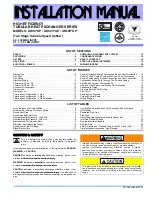
33
c.
Gas pressure OK - check for obstruction in main burner;
check to be sure electrode is positioned approximately
1/4” above and directly over slots on the main burner -
adjust electrode if necessary.
d.
Remove burner and check burner for obstructions.
Clean as required.
4.
Burner ignites, but goes off and into lockout:
a.
Check to be certain that flame sensor is over slots in the
main burner and that the main burner flame is burning
against the tip of the flame sensor - adjust by bending
sensor probe. NOTE: Sensor probe should be in the
inner blue cone of the burner flame (approximately 1/4”
to 5/16” above burner).
b.
Burner still goes off and into lockout - check wire
connections at flame sensor and at module board.
c.
Wire connections OK - check continuity through flame
sensor wire.
d.
Continuity of flame sensor wire OK - check with micro
amp meter in series with flame sensor and flame sensor
wire to be certain that the flame sensor is generating
at least seven micro amps within seven seconds after
the burner is ignited. Connect meter as follows: (+)
to sensor wire, (-) to sensor probe. Adjust position of
sensor probe, check for carbon deposits on sensor
probe if reading is less than seven micro amps.
e.
Flame sensor circuit generating at least seven micro
amps, but burner still goes off and into lockout - replace
module board.
5.
Repeated module board failures:
a.
Check to be certain that the electrode spark is not
sparking against the flame sensor portion of the
electrode assembly.
b.
Check to be sure module board or high voltage wires
are not shorted to the chamber wrapper or other furnace
parts.
c.
Be sure insulator covering the electrode wire connection
on the coil of the module board is in place and insulator
behind module board is in place.
d.
Make certain that the transformer voltage is within 24 -
30 volts A.C.
e.
Be sure duct connections to furnace are airtight. Seal
duct collar connections to furnace cabinet with duct
tape, if necessary to prevent hot air leakage. No air
leakage should exist anywhere in the duct system,
especially at connections on furnace cabinet.
f.
Be sure sensor wire terminal is tightly affixed to sensor
probe.
g.
Be sure high voltage electrode wire is in good condition
and properly positioned onto pierce point electrode.
6.
Customer complains of unit going into lockout only once
in a while:
a.
Thoroughly check electrode and burner relationship.
b.
Lockout can occur if the gas pressure fluctuates at the
time the thermostat calls for heat. Pressure fluctuations
can be caused by a malfunctioning gas bottle regulator,
an obstruction or a kink in the gas line, or moisture in
the gas bottle regulator or in the gas lines. it is difficult
to check for these fluctuations that will not noticeably
affect any other appliance in the coach. However,
isolating the furnace from the coach gas system will
determine if the gas system is responsible. This
isolation procedure can be done by connecting a
separate upright bottle, regulator and gas line directly
to the furnace, eliminating the coach gas system. if the
occasional lockout still exists, then the furnace should
be thoroughly tested to determine the cause; however,
if the furnace works properly on this separate system,
then the coach gas system should be checked.
c.
Check furnace return air and warm air discharge to be
certain sufficient air flow is present to engage micro
switch every time.
d.
Check micro switch to be sure it moves freely.
e.
Remove electrode and burner. Clean thoroughly.
SErViCE hinTS, DiaGnOSiS, and COrrECTiVE MEaSurES
FOR THE IGNITION SYSTEMS OF SUBURBAN
24 VOLT ELECTRONIC IGNITION GAS FURNACES WITH TIME DELAY








































